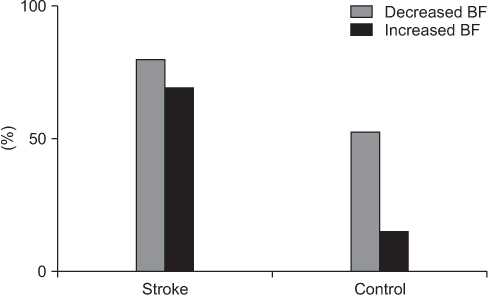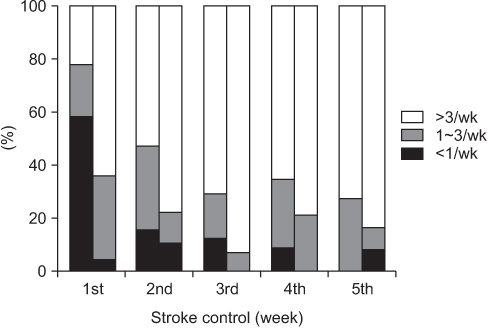Ewha Med J.
2015 Mar;38(1):22-29. 10.12771/emj.2015.38.1.22.
Characteristics of Constipation at Acute Phase of Cerebral Stroke
- Affiliations
-
- 1Department of Internal Medicine, Ewha Womans University School of Medicine, Seoul, Korea. kimse@ewha.ac.kr
- KMID: 2171325
- DOI: http://doi.org/10.12771/emj.2015.38.1.22
Abstract
OBJECTIVES
The prevalence of constipation is high after stroke. Multiple factors such as long-term bed-ridden status, comorbidity, medical illnesses are combined in this condition. However, the change of bowel movement during the early stage of stroke remains uncertain.
METHODS
Patients with first stroke who admitted in a single institute from 2008 to 2009 were reviewed retrospectively and 36 patients were enrolled. As a control group, 47 consecutive orthopedic patients needing bed rest without surgery in the same period were enrolled. Data of stroke associated factors, frequency of BM (bowel movement) during 5 weeks, use of gastrointestinal medications, and outcomes were collected from the medical records.
RESULTS
The cumulative incidence of decreased (<3/week) and severely decreased BM (<1/week) were 80.6% and 69.4% in stroke patients and 53.2% and 14.9% in control group (P<0.05). The cumulative incidence of increased BM (>3/day) was 38.9% in stroke and 14.9% in control group. In acute stroke, 58% of patient showed severely decreased BM in first week, and the proportion was rapidly decreased below 15% from second week. However, laxative use increased with hospital days. The occurrence of severely decreased BM in stroke patients was associated with National Institutes of Health Stroke Scale (NIHSS; P=0.004). Severely decreased BM was not associated with poor outcomes including death, morbidity, and stroke recurrence.
CONCLUSION
Decreased BM is common in acute stroke. The occurrence of severely decreased BM is associated with NIHSS. However, the severe manifestation occurred mainly in the first week, and considered to be well controlled by laxatives.
Keyword
MeSH Terms
Figure
Reference
-
1. Otegbayo JA, Talabi OA, Akere A, Owolabi MO, Owolabi LF, Oguntoye OO. Gastrointestinal complications in stroke survivors. Trop Gastroenterol. 2006; 27:127–130.2. Robain G, Chennevelle JM, Petit F, Piera JB. Incidence of constipation after recent vascular hemiplegia: a prospective cohort of 152 patients. Rev Neurol (Paris). 2002; 158(5 Pt 1):589–592.3. de Jong G, van Raak L, Kessels F, Lodder J. Stroke subtype and mortality: a follow-up study in 998 patients with a first cerebral infarct. J Clin Epidemiol. 2003; 56:262–268.4. Ingeman A, Andersen G, Hundborg HH, Svendsen ML, Johnsen SP. Processes of care and medical complications in patients with stroke. Stroke. 2011; 42:167–172.5. Harari D, Coshall C, Rudd AG, Wolfe CD. New-onset fecal incontinence after stroke: prevalence, natural history, risk factors, and impact. Stroke. 2003; 34:144–150.6. Su Y, Zhang X, Zeng J, Pei Z, Cheung RT, Zhou QP, et al. Newonset constipation at acute stage after first stroke: incidence, risk factors, and impact on the stroke outcome. Stroke. 2009; 40:1304–1309.7. Bassotti G, Bellini M, Pucciani F, Bocchini R, Bove A, Alduini P, et al. An extended assessment of bowel habits in a general population. World J Gastroenterol. 2004; 10:713–716.8. Aslan E, Beji NK, Erkan HA, Yalcin O, Gungor F. The prevalence of and the related factors for urinary and fecal incontinence among older residing in nursing homes. J Clin Nurs. 2009; 18:3290–3298.9. Tong X, Kuklina EV, Gillespie C, George MG. Medical complications among hospitalizations for ischemic stroke in the United States from 1998 to 2007. Stroke. 2010; 41:980–986.10. Schaller BJ, Graf R, Jacobs AH. Pathophysiological changes of the gastrointestinal tract in ischemic stroke. Am J Gastroenterol. 2006; 101:1655–1665.11. Calignano A, Whittle BJ, Di Rosa M, Moncada S. Involvement of endogenous nitric oxide in the regulation of rat intestinal motility in vivo. Eur J Pharmacol. 1992; 229:273–276.12. Dooley CP, Mello WD, Valenzuela JE. Effects of aspirin and prostaglandin E2 on interdigestive motility complex and duodenogastric reflux in man. Dig Dis Sci. 1985; 30:513–521.13. Winge K, Rasmussen D, Werdelin LM. Constipation in neurological diseases. J Neurol Neurosurg Psychiatry. 2003; 74:13–19.14. Kovindha A, Wattanapan P, Dejpratham P, Permsirivanich W, Kuptniratsaikul V. Prevalence of incontinence in patients after stroke during rehabilitation: a multi-centre study. J Rehabil Med. 2009; 41:489–491.15. Sun TK, Chiu SC, Yeh SH, Chang KC. Assessing reliability and validity of the Chinese version of the stroke scale: scale development. Int J Nurs Stud. 2006; 43:457–463.16. Nakayama H, Jorgensen HS, Pedersen PM, Raaschou HO, Olsen TS. Prevalence and risk factors of incontinence after stroke: the Copenhagen Stroke Study. Stroke. 1997; 28:58–62.17. Cardin F, Minicuci N, Droghi AT, Inelmen EM, Sergi G, Terranova O. Constipation in the acutely hospitalized older patients. Arch Gerontol Geriatr. 2010; 50:277–281.18. Pare P, Ferrazzi S, Thompson WG, Irvine EJ, Rance L. An epidemiological survey of constipation in canada: definitions, rates, demographics, and predictors of health care seeking. Am J Gastroenterol. 2001; 96:3130–3137.19. Limmer S, Ittel TH, Wietholtz H. Secondary and primary prophylaxis of gastropathy associated with nonsteroidal antiinflammatory drugs or low-dose-aspirin: a review based on four clinical scenarios. Z Gastroenterol. 2003; 41:719–728.20. Towers AL, Burgio KL, Locher JL, Merkel IS, Safaeian M, Wald A. Constipation in the elderly: influence of dietary, psychological, and physiological factors. J Am Geriatr Soc. 1994; 42:701–706.21. Thompson WG, Longstreth GF, Drossman DA, Heaton KW, Irvine EJ, Muller-Lissner SA. Functional bowel disorders and functional abdominal pain. Gut. 1999; 45:Suppl 2. II43–II47.
- Full Text Links
- Actions
-
Cited
- CITED
-
- Close
- Share
- Similar articles
-
- Coagulation-Fibrinolysis system in acute progressive and non-progressive stroke: Preliminary study
- Induced Hypertension Using Phenylephrine in Patients with Acute Ischemic Stroke: A Case Report
- Blood Pressure in Acute Ischemic Stroke
- Acute Cerebral Infarction in Carbon Monoxide Poisoning
- Occurrence of Constipation during the Rehabilitation Stage in Patient with Cerebral Vascular Disease



